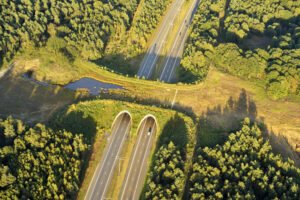Vision Zero for wildlife?
By Natasha Matsaert
In Oxford, transport is a hot topic. Thanks to Cyclox’s campaigning, Oxfordshire County Council has adopted a Vision Zero strategy which aims to eliminate all road deaths and serious injuries. It seems that the safety of cyclists and pedestrians is beginning to be taken seriously.
But one category of vulnerable road user is absent from these discussions. Where is the mention of the wildlife that shares our streets?
Wildlife and roads
Road casualty rates are highest for wild animals. Doesn’t it seem strange therefore that the County Council has not yet acknowledged these deaths in its Vision Zero policy? Given the impact of car culture on these populations it is a significant oversight.
The death toll of the much-loved hedgehog, for instance, is estimated to be over 100,000 per year.
Local hedgehog conservationist Hugh Warwick says this is “one of the reasons the nation’s favourite animal is sadly slipping away”.
Well-trodden, ancestral routes of animals like badgers also receive little or no consideration when roads are built. These routes are broken and disrupted, with tragic consequences for wildlife. Clearly, wild animals are also key stakeholders in the planning of safe, active travel. This will increasingly be the case as road networks and cities expand.
Wildlife road deaths and Vision Zero
How does the road-killing of animals fit into Vision Zero? In simple terms, it is another example of how dangerous our roads are, and how we accept this.
The flattened, unmoving bodies lining our highways are evidence of the assumption that traffic deaths are inevitable, whether they be the deaths of humans or of animals.
A focus on wildlife reinforces Vision Zero’s message that mobility will never be equitable until there are zero deaths for all road users. The call for ‘no more ghost bikes’ is also a call for ‘no more ghost animals’.
Traffic measures which help

So how might wildlife find a place in our campaign for change? There are several traffic measures which could increase the safety of both humans and animals:
- Greenways Vegetated, traffic-free paths like the Lias Line greenway in Warwickshire provide safe routes for people and wildlife. According to the sustainable transport charity Sustrans, by connecting people with nature these routes have increased walking and cycling trips.
- Green bridges and underpasses Green crossings provide wildlife with safe routes over or under roads, separating them from motor traffic. The Netherlands has reduced fatalities with more than 600 wildlife crossings. It is now creating collaborative ‘recroducts’ that are open to cyclists and walkers as well as wildlife.
- Roadside barriers Hedgerows, planters, trees, fences and other barriers beside roads can shield cyclists and animals from hazards and provide more places for wildlife to thrive.
- Lower speed limits Reducing speed limits on motorways and country roads as well as in built-up areas is a cheap and effective way to reduce traffic fatalities. A vehicle may be able to stop in time at 20 mph, but speeds of 50 mph and higher mean certain death for any animal that is in the way.
Prioritising the movement of wildlife alongside cycling and walking can support Vision Zero’s mission. It can lead to a more equitable system of transport which promotes connections with nature. As it turns out, making roads safer for wildlife is good for all of us.
